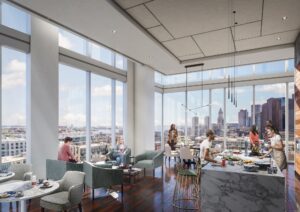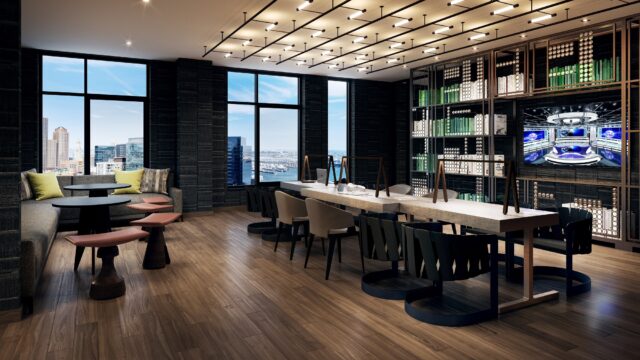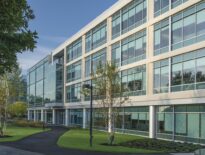
The Hub50House tower at Boston’s North Station devotes its entire 15th floor to amenities including a coffee bar, game room, business center and party room (pictured). Image courtesy of Boston Properties.
With more than 2,000 new luxury high-rise units scheduled for completion in downtown Boston by next spring, the stakes are high to deliver the latest eye-catching amenity packages to boost preleasing.
At Hub50House on Causeway Street, developer Boston Properties set aside nearly its entire 15th floor for a connected series of common areas including a business center and game room. Spanning an area that could have accommodated dozens of studio apartments, the “Hub15” floor connects to an outdoor terrace equipped with fire pits and barbecue grills, providing views from the Zakim Bridge to the Seaport. An outdoor swimming pool and sky lounge which is scheduled to open on the 38th floor next spring will offer even loftier vantages.
“It allows the developers to make smaller apartments, because people want to be in these spaces and they’re really an extension of their apartments,” said Devon Patterson, a principal at Chicago-based architects Solomon Cordwell Buenz which designed the Hub50House. “And it adds value to the units at the lower levels, because everybody has the opportunity to get the views.”
Hub50House is marketing 416-square-foot “metro” apartments for $2,620 a month.
From North Station to the South End, apartment developers no longer blanch at sacrificing some of towers’ potentially highest-renting spaces in favor of game rooms, pet spas, pool decks and lounges. With flexible work arrangements becoming more common, coworking–style areas are gaining ground. And a new tower scheduled to open in the Seaport will include 3D printing and design stations.
More Than Just Views
As individual apartments become smaller and buildings incorporate more studio units, the strength of a building’s amenity package rises in importance – and elevation. Until recently, most common areas were located on lower levels replacing some of the least valuable leasable space, said Vickie Alani, a principal at Boston-based CBT Architects.

The NEMA Boston apartment tower in Boston’s Seaport District will include co-working space for residents (pictured) and a “Creator’s Suite” equipped with 3D printing and design equipment. Image courtesy of ADD Inc.
The Seaport District’s 315 on A tower which opened in 2014 was one of the first to set the bar in Boston’s current luxury housing boom with its roof terrace and indoor sky lounge, Alani said. That influenced subsequent designs including The Sudbury, a 45-story tower that’s scheduled to open next spring in the Bulfinch Crossing redevelopment of the Government Center garage property. CBT designed the amenities area on the 32nd floor for the 368 apartments, including a sky lounge and pool terrace, along with sections split up into formal dining rooms to workout studios and party space.
Coworking–style office space is becoming a must-have feature, as developers provide perks for remote workers and residents whose employers allow flexible work arrangements.
At NEMA Boston, a 414-unit tower opening late this year at 399 Congress St. in the Seaport, tenants will have access to a coworking lounge as well as a “Creator’s Suite” equipped with 3D printing and design equipment. On the next block, residents of the 270-unit EchelonSeaport apartment tower opening next fall will have access to an innovation center and conference space located within the development’s condo tower known as 135 Seaport, A Regent Collection.
“In today’s world, more people are working from home and they don’t want to spend the entire time working in their apartment. That’s something we see people pretty focused on,” said Simon Butler, a partner at CBRE in Boston who heads the brokerage’s multifamily investment sales team.
Designing Perks to Stand the Test of Time
To help developers sort out current tenants’ must-have and want-to-have perks, the National Multifamily Investment Council this month released a national survey of 330,000 renters in more than 5,000 complexes. Among those surveyed in Greater Boston, residents said they would pay an extra $39 a month to live in a building with a swimming pool, the most popular perk after on-site childcare and parking.

Steve Adams
“The level of amenitization of these properties has been raised, and there’s a sense of having to compete,” said Rick Haughey, NMHC’s vice president of industry technology initiatives. “The new bottom threshold is they realize you have to have a really nice lobby, fitness center and spaces for people to convene, and it takes off from there.”
As with any new feature, amenity spaces are evolving as developers study which ones resonate with tenants. Home theater areas with fixed seating are on the outs, according to developers and architects, because tenants have better options for viewing media on mobile phones or inexpensive big-screen TV’s of their own. Stand-alone amenity rooms with fixed furnishings are giving way to multipurpose spaces that can be converted to the next must-have feature, CBT’s Alani said.
“It’s important for the design of a building that’s going to last for 50 or 100 years,” she said. “How do we future-proof these buildings and determine which are long-lasting and which are a fad?”
Editor’s note: This article has been updated to clarify the location of the innovation center within the EchelonSeaport development.




 |
| 
